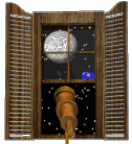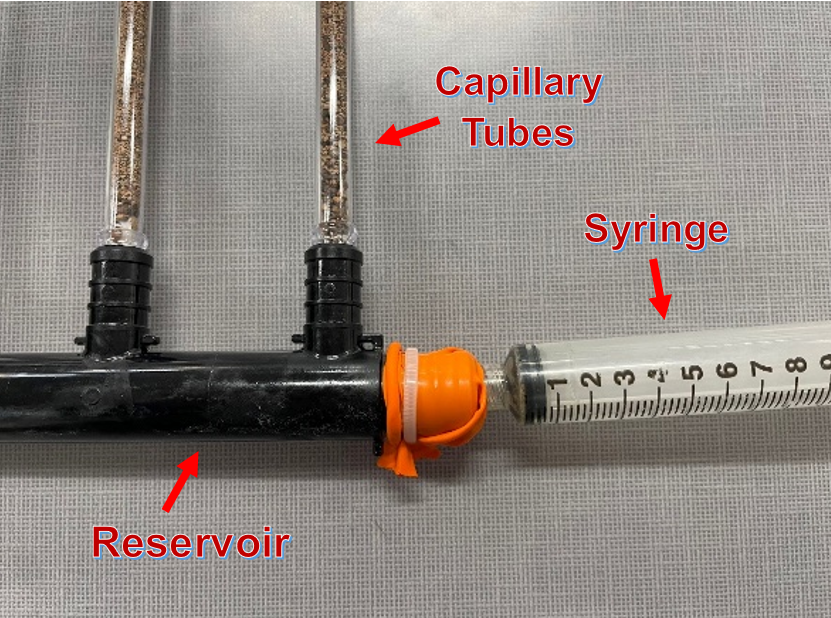Educator Onboarding
LEO Art Challenge Workshop
ICE 2019: Satellite Tracking, Orbits, and Modeling
SEEC 2019: Satellite Tracking, Orbits, and Modeling
Workshop:ITEC Trek-a-Sat
Workshop: 2018-01-27 Yerkes
Workshop: 2017-10-28 Carthage-Yerkes Electrostatics in Space
Workshop: 2017-06-29-BTCI-Life in Space!
Workshop: 2017-03-11 Yerkes
Workshop: 2017-02-07 SEEC
Workshop: 2017-01-28 Yerkes
Tools You Might Use
Educational Learning
Standards
Documentation
Water Movement in Different (Lunar) Regolith Simulants Part 2
Diagrama de temas
-
-
Author: Laura Tomlin, Salado Middle School, Salado, TX
Frances Dellutri, NSS Director of Education
Assisted by: Natalie Orrantia, Univ of Chicago Updated: August, 2023
Summary-
This is the second in a series of experiments comparing water movement in regolith simulants in reduced and microgravity environments. During the first set of experiments, students tested the rate of water intake in these different simulants, tracking water movement and finding that though the water intake increased in the Mars regolith simulant and the VEGGIE growth medium, almost no movement was seen in the lunar regolith simulant (JSC-1A). Ms. Tomlin had the opportunity to test these student experiments in different microgravity environments aboard a 0-g flight. This project allows students to investigate regolith behavior on Earth, as well as consider its behavior off world.
See Water Movement in Lunar and Martian Regolith Simulants Part 1: https://spacedge.nss.org/course/view.php?id=313
In this new set of experiments students worked with minor modifications, different types of lunar regolith simulants and additional materials, surfactant and perlite, to implement and observe in their new investigations. Students set out to understand the effects of these additional elements and how they may change the rate of lunar regolith simulant water intake.
Age of Student: 11 years +
Image Credits to GIFGIFs Services

Project Goals:
To compare water uptake in a variety of lunar regolith simulants.
To investigate methods of improving water uptake in lunar regolith simulants.
To determine or consider the effect of reduced gravity and microgravity on movement of water in lunar regolith simulants.
To provide an authentic learning experience for students which deepen understanding of force and motion, lunar exploration, capillary action, engineering design process, and scientific inquiry.
Keywords/Topics Covered:
Capillary Action, Gravity, Forces, Microgravity, Lunar regolith, Soil Texture, Water Diffusion, Artemis program, Current Lunar Research Programs, Newton’s Laws, Soil Chemistry, Engineering Design, Scientific Inquiry
US Next Generation Science Standards (NGSS) Connections:

Properties of Matter PS1.A
Force and Motion PS2.A, PS2.B
Space Systems ESS1.A, ESS1.B
History of the Earth, Earth’s Systems ESS2.A, ESS2.C, ESS3.A
Engineering Design ETS1.A, ETS1.B, ETS1.C
Required prerequisites / prior knowledge:
Microgravity Experiment Part 1: Water Movement in Lunar and Martian Regolith Simulants
Engineering design process
Experimental process
Forces and Motion: Newton’s Laws, balanced and unbalanced forces, gravity, microgravity, capillary force, adhesion, cohesion
Space Science- Space Research
Regolith and regolith simulants
Results from previous experiment
-
The following simulations are as seen in Water Movement through Regolith Simulants (Part 1):
1. PhETGravity Force Lab (Simulation)
This PhET interactive simulation provided by the University of Colorado explores the effects of mass and forces between objects. Use the links below to help students conduct their own force experiments.

https://phet.colorado.edu/en/simulations/gravity-force-lab-basics
https://phet.colorado.edu/en/simulations/gravity-force-lab
This short real-world simulation created for national astronauts day, allows students to experiment with concepts of free fall and microgravity in a hands-on, student led project.
https://docs.google.com/document/d/14RThOj_gj2EjRZqu17FIrDwBtXqZufnDzp0Hqr9ab3s/edit
-
Background:
Students had the unique opportunity through Wisconsin Space Grant’s Embedded Teacher Program to design and test experiments and equipment for flight aboard the Zero-G parabolic plane in May 2022. Students the following year were able to build upon that program by analyzing data, making modifications to the equipment, and use that equipment to narrow the scope of research. In this experiment, which was flown in November 2022, students compared the rate of water movement through different lunar regolith simulants in 1-G, lunar-G, Mars-G, and microgravity environments.
This experiment was conducted by students in the classroom at 1-G. Students reviewed balanced and unbalanced forces, Newton’s Laws of Motion, capillary action, adhesion and cohesion, and the affect of soil texture on water movement. Students then made predictions on how data would change in a reduced gravity and zero gravity environment. Classroom data was compared to data collected by Laura Tomin in 0-G and lunar-G environments aboard the Zero-G airplane.
This experiment is expected to be further modified to fly as a fully automated system on board a sub-orbital flight during the 2023-24 school year.
Materials:
Regolith / Simulant Substrate Types (used in various combinations):
JSC 1A (Lunar Mare regolith simulant)- Crushed basaltic ash, mined at Flagstaff, AZ. Similar chemistry to Apollo 14 and Apollo 17 landing sites.
NU-LHT (Lunar Highland regolith simulant)- Similar chemistry to Apollo 16 landing site.
OB-1 (Lunar Highland regolith simulant)- Similar chemistry to Apollo 16 landing site.
Exolith LHS-1 (Lunar Highland regolith simulant)- Similar chemistry to average lunar highlands.
Lunar regolith is abrasive and can irritate lungs. You MUST wear a mask and goggles when handling regolith simulants.
See MSDS Folder in Resources!

Image Credits to GIFGIFs Services
For Apparatus:Four 10 cm capillary tubes
Reservoir
Coffee Filters
Painter's tape
Velcro
Sponge stoppers
Syringe to disseminate 20 ml of water
Grid Board
Timer
Device for video recording

Procedure:
Note that capillary structure built in part one is reused during this experiment, apparatus build procedure found in part 1 is necessary to continue!
Build apparatus:
Four 10 cm capillary tubes secured in reservoir (specific build instructions in part 1!)

Tape one layer of coffee filter at bottom of tube ( using painters tape)
Fill one tube with 4 cc of lunar regolith (simulant listed above). Tap to settle regolith
Repeat in separate tubes with each type of regolith simulant
Insert sponge at top of each tube to hold soils intact and allow air diffusion
Insert syringe containing 20 ml water into reservoir, velcro to grid board.
Procedure (CLASSROOM, 1-G):
Attach syringe and capillary apparatus to grid board
Set a timer to 20 seconds
Begin filming your video (can be taken on a phone!)
Countdown, and on “Go” inject water into tube (5 second injection)
Continue filming to 20 seconds, say “20 seconds” then turn grid board upside down.
Review your video, and from your pictured results record water uptake (darkened soil) for each soil type
-
Students use the following Data Sheets to record their findings. Templates are attached below.
 Image Credits to GIFGIFs Services
Image Credits to GIFGIFs ServicesQuestions / Conclusion: (whole class or addressed in groups)

Which lunar regolith/substrate had greatest diffusion of water?
Why do you believe water moved more easily?
Which lunar regolith/substrate had the least diffusion of water?
Why do you believe water did NOT move as easily?
What is the purpose of adding a SURFACTANT (wetting agent) in water?
Did adding the surfactant affect water movement in lunar regolith? Why or why not?
Did adding pearlite in lunar regolith increase water diffusion in lunar regolith? Explain why.
Explain the force of capillary action in water movement:
Do you think the rate of water movement in lunar regolith will change in lunar gravity? (Explain using Newton’s Laws, balanced / unbalanced forces)
Do you think the rate of water movement in lunar regolith will change in microgravity? (Explain using Newton’s second law)
Why is understanding how water moves in lunar regolith important?
What changes would you make, or other experiments would you like to see using regoliths?
-
Two printable versions available for students to use!
-
Additional Resources:
Videos, Interactives, Demonstrations, Simulations, etc.
Video: Regolith simulants
- Surface Tension Paperclip and Boat activity
Astronaut in a bottle:
Walking water experiment
Break the Tension
https://docs.google.com/document/d/1-tPWeiAyI3pZuOXiOk5y-uIGRTyjer6VzdWAJCUZpKU/edit?usp=sharing
Astronaut in a Bottle
PhETGravity Force Lab (Simulation)
https://phet.colorado.edu/en/simulations/gravity-force-lab-basics
https://phet.colorado.edu/en/simulations/gravity-force-lab
NASA Technical Reports (search by topic)
-
Send a Postcard to Space through NSS Supported Blue Origin Club For The Future initiative!
Visit: SpacEdge Academy Postcards in Space Course

